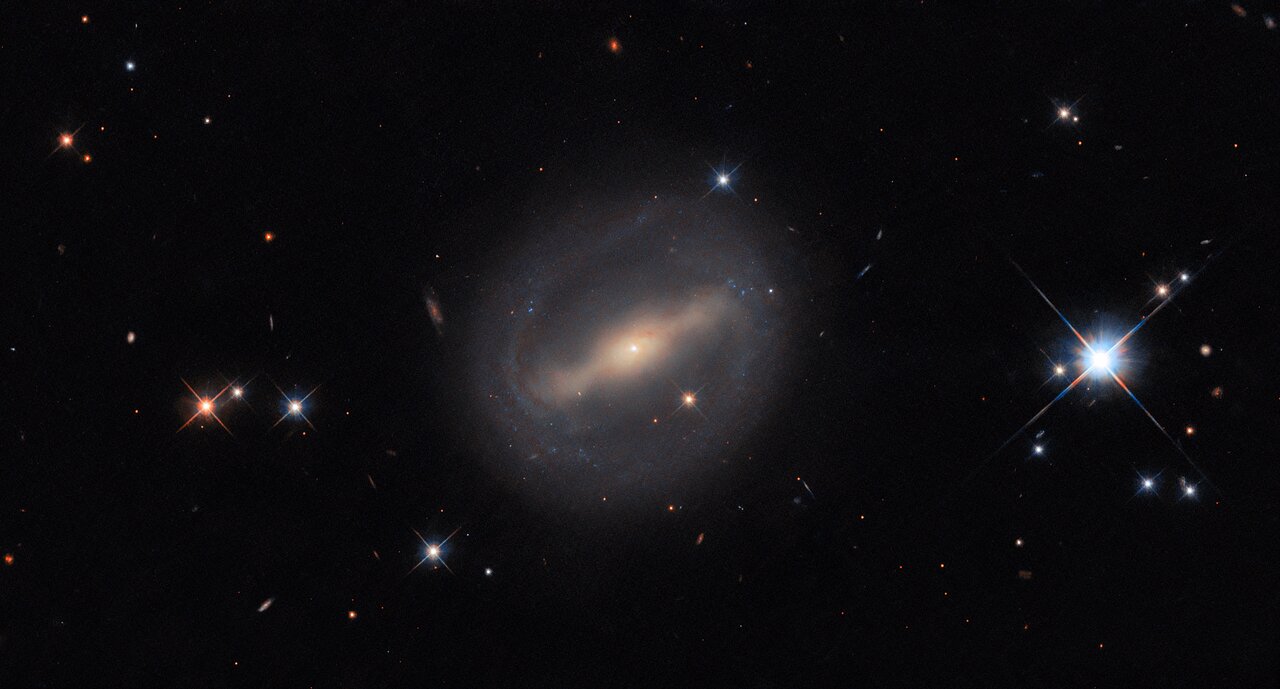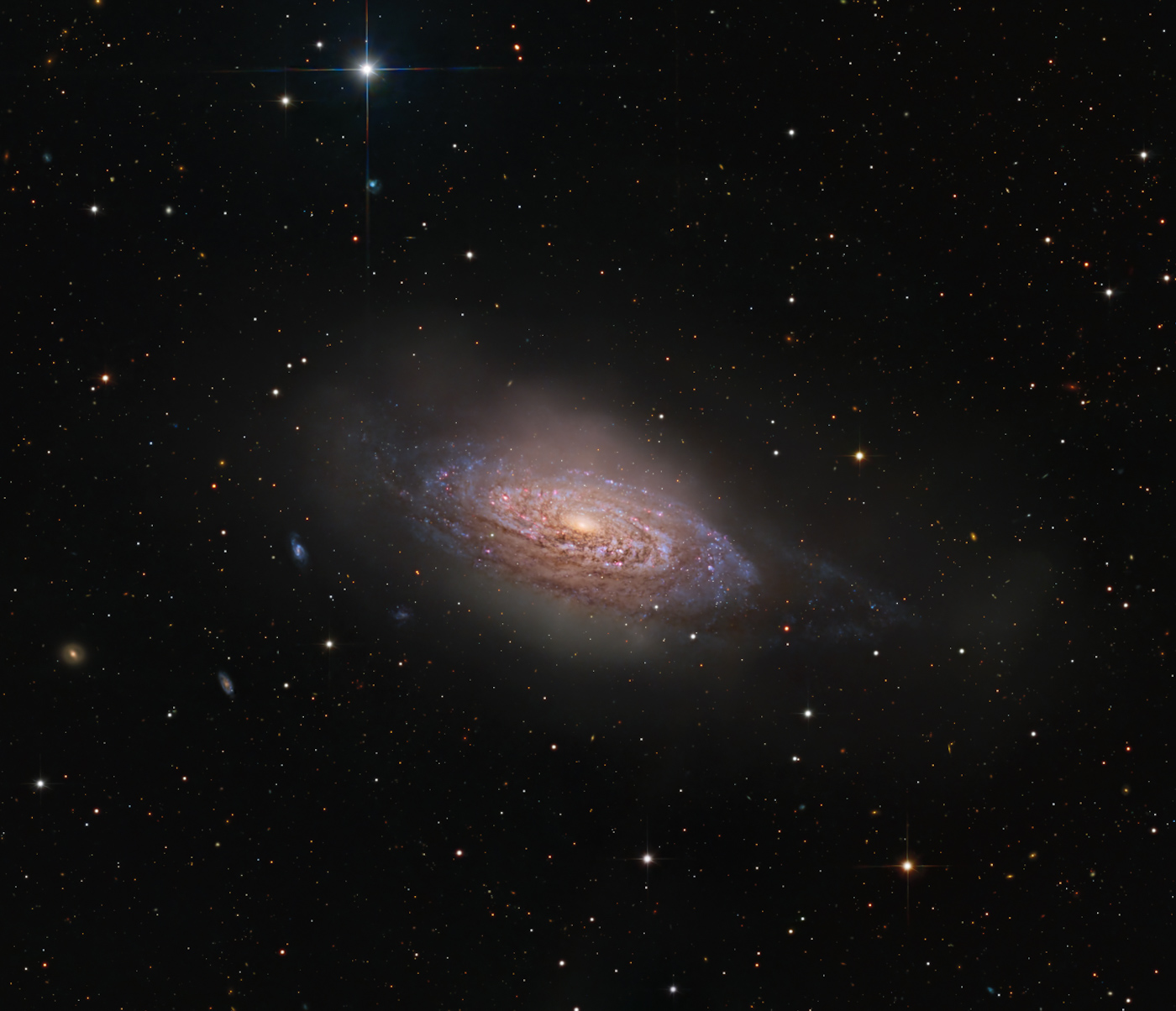Blog
“Big Chief” Russell Moore (August 13, 1912 – December 15, 1983) was an American jazz trombonist. Moore, a Pima tribe member, grew up on a Native American reservation before moving to Chicago and then Los Angeles where he learned to play various instruments, eventually settling on trombone. Throughout his career, Moore worked with an array of artists including Frank Sinatra, Lionel Hampton, Alberta Hunter and Pee Wee Russell as well as recording under his own name. He is best remembered for his work as a member of Louis Armstrong’s band.
more...The subject of this week’s circular Hubble Picture of the Week is situated in the Perseus Cluster, also known as Abell 426, 320 million light-years from Earth. It’s a barred spiral galaxy known as MCG+07-07-072, seen here among a number of photobombing stars that are much closer to Earth than it is.
MCG+07-07-072 has quite an unusual shape, for a spiral galaxy, with thin arms emerging from the ends of its barred core to draw a near-circle around its disc. It is classified, using a common extension of the basic Hubble scheme, as an SBc(r) galaxy: the c denotes that its two spiral arms are loosely wound, each only performing a half-turn around the galaxy, and the (r) is for the ring-like structure they create. Rings in galaxies come in quite a few forms, from merely uncommon, to rare and astrophysically important!
Lenticular galaxies are a type that sit between elliptical and spiral galaxies. They feature a large disc, unlike an elliptical galaxy, but lack any spiral arms. Lenticular means lens-shaped, and these galaxies often feature ring-like shapes in their discs. Meanwhile, the classification of “ring galaxy” is reserved for peculiar galaxies with a round ring of gas and star formation, much like spiral arms look, but completely disconnected from the galactic nucleus– or even without any visible nucleus! They’re thought to be formed in galactic collisions. Finally, there are the famous gravitational lenses, where the ring is in fact a distorted image of a distant, background galaxy, formed by the ‘lens’ galaxy bending light around it. Ring-shaped images, called Einstein rings, only form when the lensing and imaged galaxies are perfectly aligned.
[Image Description: A galaxy. It is almost circular. It has a glowing bar stretching across its core; from the ends of the bar, thin spiral arms wrap around the galaxy to form a closed disc. The arms are fuzzy from the dust and stars they contain. The galaxy is on a black, mostly-empty background. A few foreground stars with cross-shaped diffraction spikes can be seen, as well as some distant galaxies in the background.]

Patrick Bruce Metheny (born August 12, 1954) is an American jazz guitarist and composer.
He was the leader of the Pat Metheny Group (1977–2010) and continues to work in various small-combo, duet, and solo settings, as well as other side projects. His style incorporates elements of progressive and contemporary jazz, latin jazz, and jazz fusion. He has three gold albums and 20 Grammy Awards, and is the only person to have won Grammys in 10 categories.
Metheny was born in Lee’s Summit, Missouri.
more...
Peter Ostroushko (August 12, 1953 – February 24, 2021) was an American violinist and mandolinist. He performed regularly on the radio program A Prairie Home Companion and with a variety of bands and orchestras in Minneapolis–Saint Paul and nationally. He won a regional Emmy Award for the soundtrack he composed for the documentary series Minnesota: A History of the Land(2005).
Born August 12, 1953, and of Ukrainian ancestry, Ostroushko grew up in northeast Minneapolis where he first took up mandolin at age three.
more...Mark Freuder Knopfler OBE (born 12 August 1949) is a British guitarist, singer, songwriter, and record producer. He was the lead guitarist, singer and songwriter of the British rock band Dire Straits from the group’s formation in 1977 until their dissolution in 1995. He pursued a solo career after the group disbanded, and is now an independent artist.
Knopfler was born in Glasgow, and raised in Blyth, near Newcastle, England. After graduating from the University of Leeds and working for three years as a college lecturer, Knopfler co-founded Dire Straits with his younger brother, David Knopfler. The band recorded six albums, including Brothers in Arms (1985), one of the best-selling albums in history. After Dire Straits permanently disbanded in 1995, Knopfler began a solo career, and has produced nine solo albums. He has composed and produced film scores for nine films, including Local Hero (1983), Cal (1984), The Princess Bride (1987), Wag the Dog (1997) and Altamira(2016). He has produced albums for Tina Turner, Bob Dylan, and Randy Newman.
Described by Classic Rock as a virtuoso, Knopfler is a fingerstyle guitarist and was ranked 27th on Rolling Stone‘s list of the “100 Greatest Guitarists of All Time”.With Dire Straits, Knopfler sold between 100 million and 120 million records. A four-time Grammy Awardwinner, Knopfler is the recipient of the Edison Award, the Steiger Award and the Ivor Novello Award, as well as holding three honorary doctorate degrees in music from universities in the United Kingdom. Knopfler was inducted into the Rock and Roll Hall of Fame as a member of Dire Straits in 2018.
more...Roy James Gaines (August 12, 1937 – August 11, 2021) was an American Texas blues and electric blues guitarist, singer and songwriter. He wrote and recorded the song “A Hell of a Night”, which was first issued on his 1982 album Gainelining. He was the younger brother of the blues musician Grady Gaines.
Gaines was born in Waskom, Texas on August 12, 1937, and relocated with his family to Houston when he was six years old. Originally a piano devotee, Gaines moved to playing the guitar in his adolescence. In his teens he was acquainted with another budding guitarist, Johnny Copeland. By the age of 14 he had performed onstage backing his hero, T-Bone Walker, and played in Houston nightclubs. He later moved to Los Angeles, California.
more...Sunday August 11th 2024 930am service accompaniment with Jayson Rodovsky and quartet and choir. Jazz Service. At Redeemer Lutheran Church in White Bear Lake.
more...NGC 3521 is a flocculent intermediate spiral galaxy located around 26 million light-years away from Earth in the constellation Leo. It has a morphological classificationof SAB(rs)bc, which indicates that it is a spiral galaxy with a trace of a bar structure (SAB), a weak inner ring (rs), and moderate to loosely wound arm structure (bc).The bar structure is difficult to discern, both because it has a low ellipticity and the galaxy is at a high inclination of 72.7° to the line of sight. The relatively bright bulge is nearly 3/4 the size of the bar, which may indicate the former is quite massive. The nucleus of this galaxy is classified as an HII LINER, as there is an H II region at the core and the nucleus forms a low-ionization nuclear emission-line region.

John Arthur “Johnny” Van Derrick (* 11 August 1926 in Ealing; † 15 May 1995 in Denham, Buckinghamshire) was a British Jazz violinist, who also worked as session musician in pop music.
Van Derrick was introduced to music by his father, a Dutch cornet player. He attended the conservatory in Brussels, and until the outbreak of the Second World War he received a classical musical training. In London during the war he played trumpet in dance bands, initially Louis Mexano’s Accordion Band, before joining the merchant navy. In the post-war years he played trumpet in the dance bands of Maurice Winnick and Lou Preager. Subsequently, he took violin lessons with his mentor Sascha Lasserson and played in the Halle Orchestra, before setting up as a freelance musician. He appeared with Roy Fox and Geraldo, and in the early 1960s played in the Diz Disley String Quintet, with which he made his first recording (At the Jazz Band Ball), as well as with Tubby Hayes, Gary Potter and the Jack Toogood Swingtet. In 1976, after serious illness, he was able to start working again.
more...Jess Alexandria Stacy (born Jesse Alexander Stacy;August 11, 1904 – January 1, 1995) was an American jazz pianist who gained prominence during the swing era. He may be best remembered for his years with the Benny Goodman band during the late 1930s, particularly his performance at Goodman’s 1938 concert at Carnegie Hall.
Jess Stacy was born in Bird’s Point, Missouri, a small town across the Mississippi River from Cairo, Illinois, to Frederick Lee Stacy, a railroad engineer, and Sara (Alexander) Stacy, a seamstress. His first piano teacher was Mabel Irene Bailey, who played piano for silent movies.
more...Messier 20, popularly known as the Trifid Nebula, lies about 5,000 light-years away toward the nebula rich constellation Sagittarius. A star forming region in the plane of our galaxy, the Trifid does illustrate three different types of astronomical nebulae; red emission nebulae dominated by light from hydrogen atoms, blue reflection nebulae produced by dust reflecting starlight, and dark nebulae where dense dust clouds appear in silhouette. The reddish emission region, roughly separated into three parts by obscuring dust lanes, is what lends the Trifid itspopular name. The cosmic cloud complex is over 40 light-years across and would cover the area of a full moon on planet Earth’s sky. But the Trifid Nebula is too faint to be seen by the unaided eye. Over 75 hours of image data captured under dark night skies was used to create this stunning telescopic view.

Ian Scott Anderson MBE (born 10 August 1947) is a British musician best known for his work as the singer, flautist, acoustic guitarist, primary songwriter, and sole continuous member of the rock band Jethro Tull. He is a multi-instrumentalist who also plays harmonica, keyboards, bass guitar, bouzouki, balalaika, saxophoneand a variety of whistles. His solo work began with Walk into Light in 1983; since then he has released another five albums, including the sequel to the 1972 Jethro Tull album Thick as a Brick, titled TaaB 2: Whatever Happened to Gerald Bostock? (2012).
more...Clarence Leonidas Fender (August 10, 1909 – March 21, 1991 Anaheim, CA) was an American inventor and founder of the Fender Musical Instruments Corporation.
Fender designed the company’s iconic early instruments: the Fender Telecaster, the first mass-produced solid-body electric guitar; the Fender Stratocaster, among the most iconic electric guitars; and the Fender Precision Bass, which set the standard for electric basses. He also designed the Fender Bassman amplifier, which became the archetype for later amplifiers (notably by Marshall and Mesa Boogie) that dominated rock and roll music. Fender, who was not a guitarist himself, was inducted into the Rock and Roll Hall of Fame in 1992.
more...More Posts
- Joe McPhee
- Henry Grimes
- Billy Mitchell
- Ruma Guha Thakurta
- World Music with Cheng Yu and Dennis Kwong Thye Lee
- Daily Roots with Linval Thompson
- Ralph Berlovitz Memorial
- All Souls Day 2021
- The Cozmos with MACS J0138
- Keith Emerson
- Phil Woods
- Bunny Berigan
- Beryl McBurnie
- World Music with Sunny Jain
- Daily Roots with Justin Hinds
- Dia de los Muertos 2021
- The Cozmos with NGC 6984
- Lyle Lovett
- Rick Grech
- Little Johnny Jones